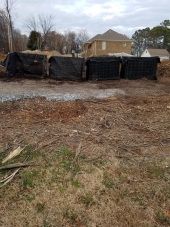Helo I am hoping for some specific help on designing garden space using sheet mulch and the resources I have on hand. For starters we live in the Puget sound region Zone 8B on a southwest facing 4% grade lot of 2.4 acres. I'm a manager of a TJ's grocery store and daily I bring home anywhere between 50-120 pounds of food bank rejected produce. This is fruits and veggies not consisting of citrus and alliums as it almost all goes to our Animals. on that note we have three pigs (two AGH gilts, and an intact Kune Kune); four goats 9two two mate and two wethers; 14 hens for laying and scratching
compost; and lastly three rabbits for meat and just as improtant fertilizer. All of this is new to both my wife and I as we did not grow up in a farming community though we did grow up with connections to food being of high importance. More of my resources are as follows:
-Endless cardboard from work as long as I feel like removing tape and stickers.
-2-5 Gallons of coffee grounds Daily
-As we live in the PNW there is an abundance of pine (Douglas Fir) trees and by that wood chips. Chunky not fine or sawdust.
-As stated above our animals provide us with manure but it's the rabbits that provide the most valuable as I understand.
-We have to buy straw at $9-$10 a bale for the animals bedding and then that all gets composted in a pile for our chickens to scratch or composted in place.
My current process is I use a 165' mobile electric fence to have the pigs root up the ground and remove much of the grass in just a few days. Then I plan to cover the area in carboard, followed by coffee grounds/rabbit manure,whatever straw I have partially composted (Some a few months of composting) and to top it all off wood chips a few inches thick.
My worries with this is one is this in good order? two will the pine tree wood chips tie up too much Nitrogen?
Also can I use Wood chips as bedding as it is much cheaper for 20 cubic yards for $50 to $75 delivered?
The space I am working on is three garden plots ranging from 1400 sq ft to 2400 sq ft, where I plan to create polycultures of annuals along with perrenials.
Seperately I am looking forward to planting many fruit and nut trees (food Forest) in about 28,000 square feet and then later much more.
I am sorry if this is far too broad/vague I am excited as I have been absorbing info to the point of paralysis. Thank you so much for reading!






.jpg)


